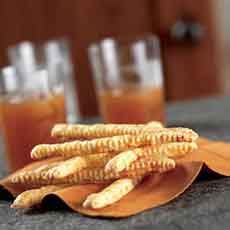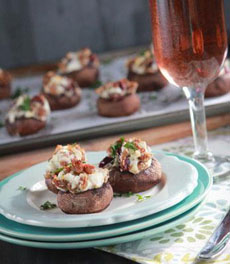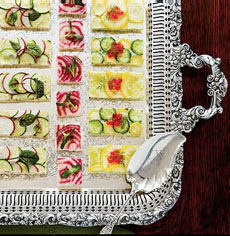TIP OF THE DAY: Freeze Your Hot Appetizers

|
If you want to serve hot hors d’oeuvre on Christmas, New Year’s Eve or other party times, here’s a tip we learned years ago from our friend Carol’s mother, a hostess whose board was almost groaning under the weight of her lavish spreads:
Make fancy appetizers in advance, freeze them and simply heat them when guests arrive. Just about every hot hors d’oeuvre can be made up to six weeks in advance and popped into the freezer. Then when the first guests arrive, just pop a baking sheet in the oven. What can you make? For starters, these 10 crowd favorites: As with anything you stick in the freezer, use airtight containers or heavy-duty resealable plastic bags. |
|
|
Hors d’oeuvre (pronounced or-DERV and spelled without an “s” at the end in French, whether singular or plural) are one- or two-bite tidbits served with cocktails. They can be placed on a table for self-service, or passed on trays by the host or a server. |
||
|
The ancient Greeks and Romans served bits of fish, seasoned vegetables, cheese and olives before the main meal. By the time of Renaissance Italy, the hors d’oeuvre had become more elaborate. Which brings up the meaning of the term:
Hors d’oeuvre is French for “outside the [main] work,” referring to foods served outside of the main meal. From the late 17th century through the mid-19th century, popular hors d’oeuvre for the affluent French included clams and oysters on the half shell, stuffed eggs, slices of beef tongue and quail tidbits. [Source] Talk about excess: In the 19th century, extending into the 20th century, salted nuts, olives, and crudités—the “relish tray” of raw carrots, celery, radishes and the like–would be on the table throughout the meal so people could fill in between courses. Technically, the term hors d’oeuvre refers to small, individual food items that have been prepared by a cook. Thus, a cheese plate is not an hors d’oeuvre, nor is a crudité tray with dip, even though someone has cut the vegetables and made the dip. Canapés—small crustless pieces of bread† or pastry with a savory topping—arose in France in the 18th century, with Britain adopting the practice in the 19th century. Canapés have been joined in modern times by hot options such as baby lamb chops, brochettes (skewers), cheese puffs, crab cakes, mini quiches and many other options. A more modern approach is the mixed appetizer plate, several pieces plated and served as an appetizer (first course). [Source] |
|
|
|
_________________________________________
*A 17th century English idiom, “groaning board” refers to a dining table laden or buffet with a large amount of food. In old literature, we see it referred to regularly by characters staying or supping at a tavern. The “groan” refers to the purported creaking and groaning noises produced by the wood of the table under the weight of the food. At the time, “board” was another word for “table” (and is the genesis of “room and board” and “boarding house”). At major feasts, the large table required was often a long board held up by trestles—think sawhorse held up by wooden legs. †Stale bread was often used as a base for the toppings, as it had hardened into the consistency of toast. The crusts were always removed to make them more elegant. |
||


